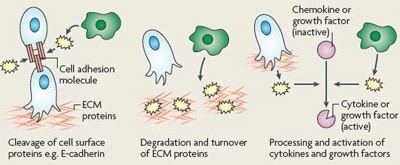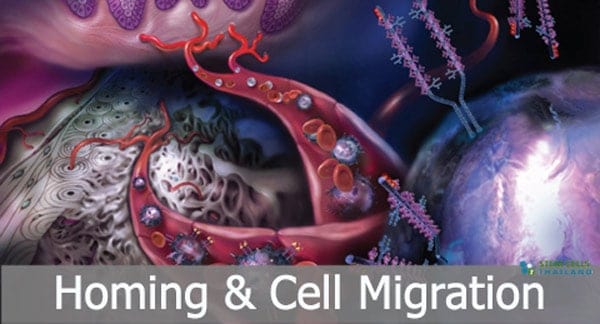Stem cell homing refers to the process by which stem cells migrate to and engraft, or settle, in a specific tissue or organ after transplantation or infusion. It’s a crucial aspect of stem cell therapy, especially in hematopoietic stem cell transplantation (HSCT), which is commonly used to treat certain types of cancer, like leukemia and lymphoma, among other diseases.
Several factors are involved in the process of stem cell homing:
- Chemotaxis: This is the movement of cells in response to specific chemical signals. In the context of stem cell homing, fractalkine and chemokines are the primary molecules that guide the stem cells to their desired location. For instance, stromal cell-derived factor 1 (SDF-1) and its receptor CXCR4 play a critical role in the homing of hematopoietic stem cells to the bone marrow.
- Adhesion molecules: Once stem cells approach the target tissue, they must adhere to the local cells and extracellular matrix. This adhesion is facilitated by various molecules, such as integrins, selectins, and cadherins.
- Extracellular matrix (ECM) degradation: To penetrate tissues and find their niche, stem cells might need to break down components of the ECM. Enzymes like matrix metalloproteinases (MMPs) help in this process.
- Homing efficiency: Not all transplanted stem cells home to the desired location. The efficiency can be affected by various factors, including the age and health of both the donor and the recipient, the method and source of stem cell collection, the conditioning regimen prior to transplantation, and other factors.
Enhancing the stem cell homing process: Given the importance of stem cell homing in transplantation outcomes, researchers are continually looking for ways to enhance this process. Strategies to enhance can include:
- Priming stem cells: This involves treating stem cells before transplantation with factors that increase their homing ability, such as certain cytokines.
- Modifying the target tissue environment: This could mean manipulating the levels of chemokines in the target tissue to make it more attractive to stem cells.
- Engineering MSC stem cells: Techniques like gene therapy can be used to overexpress certain receptors on stem cells to increase their responsiveness to chemokines.
Homing is another term used to describe the Migration of stem cells through your peripheral blood and across the entire endothelial vasculature system into different organs in the body.
Process of Homing and Migration | VIDEO
The ongoing issue in the subject of cell-established treatments is the delivery of the cells to the site of harm, a procedure termed “homing.” The remedial effectiveness of Mesenchymal stem cells is substantially influenced by their skill to generate juxtacrine or paracrine variables that improve regeneration from endogenous (stalk) cells. For the juxtacrine effects to be potential, migration of Mesenchymal stem cells to the diseased organs such as liver or kidney cells are recruited. Homing and migration to the tissue of harm is determined by many variables including passing rate,age of patient, amount of the delivery system, culturing growth medium, and the adult stem cells themselves among others.[1]
The regeneration centre of Thailand uses allogeneic and autologous cells in treatments that need active navigation, This procedure is better known as homing. Homing or migration of cells is the fundamental basis of modern stem cell transplantations. Likewise, the homing mechanism of cells is much needed for seeding the progenitor cells during the development stage.[2]


Homing has a direct physiological effect in homeostasis for adults. Such a state can also be amplified during stress causing recruiting of leukocytes during stem cell mobilization. Homing and cell migration is considered to be an unified, measure procedure, which is indicated by:
- SDF1 or stromal-derived variable 1
- SPGF – Cell Specific Growth Factors
- SCF or stem cell growth factors
- Activation of lymphocyte function-related antigen 1 (LFA1)
- VLA antigen 4/5
- CD44
- Cytoskeleton rearrangement
- MT1
- MMP or Matrix Metalloproteinase activation
- Steady secretion of MMP 2/9
Adhesion of the progenitor to endothelial cell in sinusoids under blood flow is followed by trans-endothelial migration across the physical endothelium and ECM or extracellular matrix.The injected Stem cells complete their homing journey by anchoring their specialized markets in the endosteum area and periarterial areas.[3]
Hematopoietic stem cells reside in our bone marrow but can be forced out into the bloodstream to find their way to cells in distress. This automatic reaction is what is known as mobilization and is used clinically in our therapies to help harvest large numbers of adult cells for transplantation.
Published Clinical Citations
[1] ^ S.L. Seneviratne, A.P. Black, L. Jones, A.S. Bailey, G.S. Ogg, The role of skin-homing T cells in extrinsic atopic dermatitis, QJM: An International Journal of Medicine, Volume 100, Issue 1, January 2007, Pages 19–27, https://doi.org/10.1093/qjmed/hcl132
[2] ^ Chavakis E, Urbich C, Dimmeler S. Homing and engraftment of progenitor cells: a prerequisite for cell therapy. J Mol Cell Cardiol. 2008;45(4):514–22. https://doi.org/10.1016/j.yjmcc.2008.01.004.e
[3] ^ Shiba Y, Takahashi M, Hata T, Murayama H, Morimoto H, Ise H, Nagasawa T, Ikeda U. Bone marrow CXCR4 induction by cultivation enhances therapeutic angiogenesis. Cardiovasc Res. 2009;81(1):169–77. https://doi.org/10.1093/cvr/cvn247

